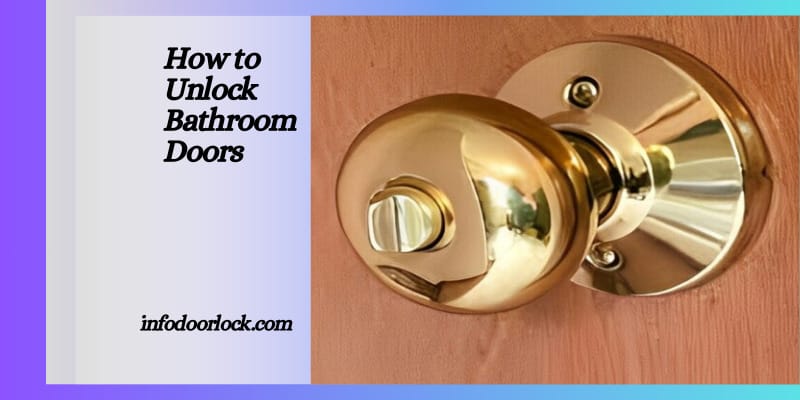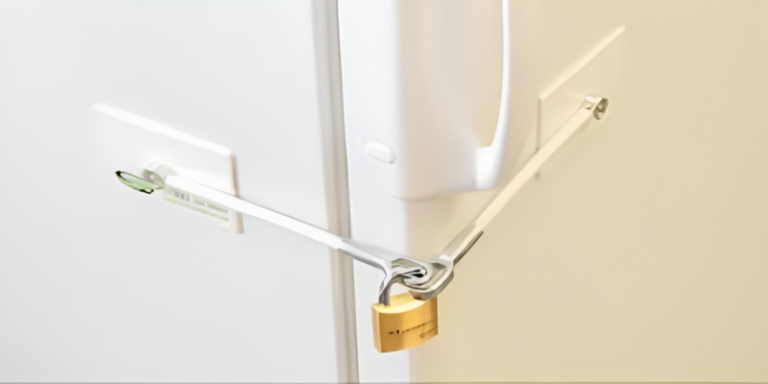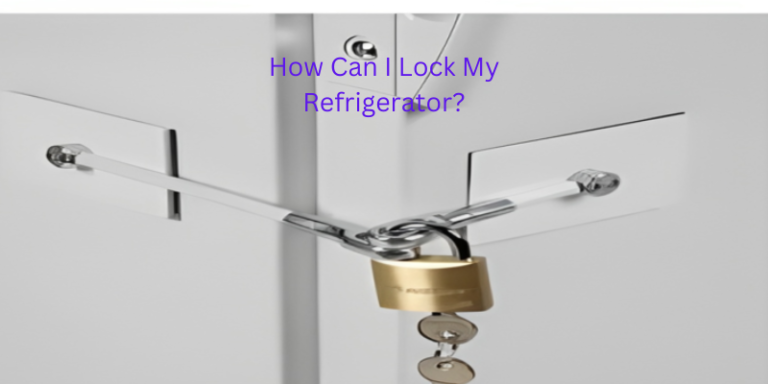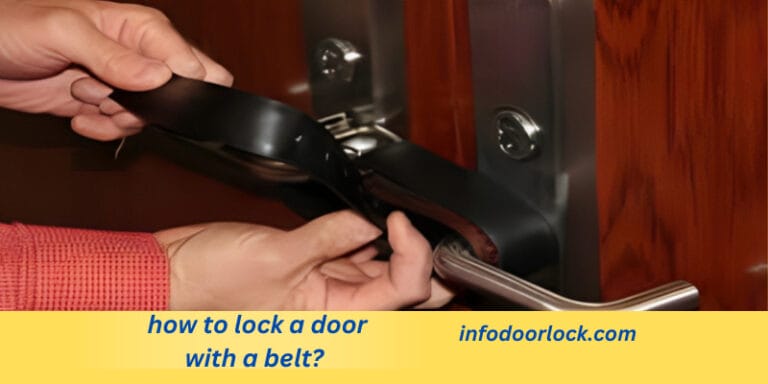How to Unlock Bathroom Doors? (Detailed Guide 2024)
Finding yourself on the wrong side of a locked lavatory door may be anything from a minor inconvenience to a real difficulty, in particular if it happens at an inopportune moment. Whether it’s a simple accident or a lock malfunction, understanding a way to take care of the state of affairs can prevent time, strain, and potentially the value of a locksmith.
This guide is designed to empower you with the know-how and confidence to liberate lavatory doorways efficiently using the equipment you likely have around your property. With a touch of persistence and a sprinkle of DIY spirit, you will find out that regaining admission to your bathroom may be easier than you thought. To release a bathroom door, first become aware of the form of lock (push-button, turn button, or key lock).
For push-button locks, use a thin, pointed object like a paperclip to press the release button inside the small hollow on the doorknob. For turn button locks, a flathead screwdriver inside the slot at the out of doors knob usually does the trick. If the door is locked with a key, a bobby pin or paperclip would possibly work for simple locks; however, it’s often high-quality to call a professional to avoid damage. Always continue lightly to keep the lock or door from being detrimental.

Why Bathroom Doors Get Locked: Understanding Common Causes
- Bathroom doors getting locked, both intentionally and by coincidence, is a state of affairs many of us have encountered.
- The motives for these lock-ins can vary widely, but expertise in the not unusual reasons can help us put together a better plan for such situations.
Accidental Lock-ins
- One of the most common reasons for locked restroom doors is unintentional lock-ins. This often occurs in houses with children or even adults, wherein the lock is engaged without realizing it, and the door shuts in the back. These situations, even though common, are normally trustworthy to solve with minimum strain.
Faulty Locks
- Over time, door locks can wear out or malfunction due to diverse factors, including rust, internal wear, or unsuitable installation. Faulty locks can either fail to open in spite of the correct handling or can lock themselves because of a malfunction within the locking mechanism.
Jammed Door Mechanisms
- Bathroom doors might also turn out to be unresponsive due to jammed door mechanisms. Humidity and frequent exposure to water can cause door components to swell or corrode, leading to jamming. Regular preservation can help mitigate such issues; however, they could nevertheless occur.
Tools You Might Need to Unlock Bathroom Doors
- Being organized with the proper tools could make unlocking a toilet door a far less daunting challenge.
- Fortunately, most of the gear required for this activity is a normal family object, which can be easily found in most homes.
Paper Clips and Bobby Pins
- These not unusual family objects may be transformed into makeshift lock-selecting tools with a little bending and manipulation.
- They are specifically beneficial for managing easy push-button or twist-button locks, where putting and wiggling the improvised device can disengage the lock.
Screwdrivers
- A small or medium-sized flathead screwdriver may be a versatile tool for your unlocking arsenal.
- It can be used to show privacy locks or to cast off hinge pins in more difficult conditions, permitting you to take the door off its hinges.
Credit Cards
- A credit card or any flexible plastic card can be used to jimmy open a lock by sliding it between the door and the frame.
- This approach is more suitable for spring locks, which might be much less commonplace in toilets, but is nevertheless really worth an attempt in a pinch.
Lock Picking Set
- For the more adventurous or people with lock-picking knowledge, a basic lock choosing set can be available.
- However, using such a fixed method requires exercise and skill, and it’s vital to apply it responsibly and legally.
Step-by-Step Unlocking Methods for Bathroom Doors
Encountering a locked bathroom door may be a frustrating experience. Whether it is because of an accidental lock-in or a defective mechanism, knowing how to tackle the state of affairs is critical. Below, we’ll explore various unlocking strategies tailor-made to the form of a lock on your restroom door.

Unlocking Push-Button Door Locks
Find a Thin Object:
- Gather a small, thin object, which may include a paperclip, a small nail, or a straightened bobby pin.
Straighten the object:
- If using a paperclip or bobby pin, straighten it out to create a long, thin tool.
Insert the object:
- Carefully insert the handle of your tool into the hollow placed within the center of the doorknob.
Apply Pressure:
- Gently practice straining by pushing straight in. You ought to experience some resistance.
Disengage the Lock:
- Continue making use of stress until you sense the lock mechanism deliver, and the button pops out, unlocking the door.
Unlocking Turn Button Locks
Use a flathead Screwdriver:
- Locate a small or medium-sized flathead screwdriver. A small nail document can also work in a pinch.
Insert the Screwdriver:
- Carefully insert the end of the screwdriver into the slot on the outside part of the doorknob.
Find the groove:
- Gently rotate the screwdriver till you feel it slot into the groove of the locking mechanism.
Turn to Unlock:
- Apply a slight amount of stress to the screwdriver. This motion needs to disengage the locking mechanism, permitting you to open the door.
Dealing with Traditional Key Locks
Assess the lock:
- Examine the lock to determine if it is a simple mechanism that might be tackled with primary tools.
Use lockpicking tools:
- If you’re skilled, you could possibly use a tension wrench and a choice. Insert the tension wrench into the bottom of the keyhole, apply slight pressure, and use the pick out to lift the pins.
Preventing Future Lockouts
- Avoiding future lockouts saves time and trouble. Here are some realistic recommendations to keep your restroom reachable:
Use caution with Locks:
- Remind household contributors of the importance of no longer locking toilet doors unnecessarily, especially in homes with children or elderly citizens.
Keep a spare key:
- If your restroom uses a key lock, keep a spare in a steady, reachable place.
Consider lock upgrades:
- Installing locks that can be unlocked from the outside without special gear can provide peace of mind and introduce protection.

Table:How to Unlock a Bathroom Door Twist Lock?
Here’s a simplified table to guide you through unlocking a bathroom door with a twist lock:
| Step | Action | Details |
| 1 | Identify the Lock | Confirm that the lock is a twist lock, usually found on the knob or handle. |
| 2 | Find a Suitable Tool | A flathead screwdriver or a coin works best. Even a thick piece of plastic might do the trick. |
| 3 | Insert the Tool | Gently insert the flat end of your tool into the slot or groove of the twist lock. |
| 4 | Apply Pressure and Turn | Apply gentle pressure and turn the tool. Twist locks usually unlock with a simple turn. |
| 5 | Open the Door | Once the lock disengages, turn the handle or knob to open the door. |
Recall to use caution so as not to harm the door or lock. It might be time to think about hiring a professional if you still can’t get the door unlocked after multiple efforts.
When to Hire a Skilled Locksmith
- While many locked toilet door conditions may be resolved with easy DIY techniques, there are instances where calling in a professional locksmith is the wisest course of action.
- Understanding how to make this name can prevent damage to your door or lock and ensure your own home’s safety isn’t compromised.
High-Security Locks
- If your restroom door is equipped with an excessive-security lock, attempting to release it without the proper expertise can result in damage to the lock’s problematic mechanisms.
- These locks are designed to withstand tampering, and a professional locksmith could have the essential tools and understanding to address them without inflicting damage.
Risk of Damage
- If there’s a danger of inflicting damage to the door, frame, or lock throughout your unlocking attempts, it is excellent to consult an expert.
- Locksmiths have the ability to release doors with minimal to no damage, making sure your lavatory door stays in the appropriate circumstances.
Emergency Situations
In situations where time is of the essence and a baby is locked inside the restroom, it’s important to call a professional locksmith right away. Their prompt carrier can clear up the state of affairs quickly and competently.

Conclusion: How to Unlock Bathroom Doors
- Navigating the assignment of a locked bathroom door shouldn’t be a frightening task. With the proper know-how and a few fundamentals, maximum lockouts may be resolved rapidly and without harm.
- From using ordinary household items like paper clips and screwdrivers to information about the mechanics of various kinds of locks, we have blanketed vital strategies to regain access to your rest room.
- However, in order to avoid damaging your door or lock, it’s imperative that you approach each situation carefully. Recall that not every lockout is the same and that solutions for one lock might not be suitable for another.
- Use safe unlocking methods and be aware of when to contact a professional locksmith, especially when dealing with sophisticated locks or in an emergency.
- Empowered with this manual, unlocking restroom doors can be a doable venture, ensuring you are prepared for any lockout scenario.
- Stay knowledgeable, live safely, and, while unsure, don’t hesitate to seek professional assistance to protect your house and cherished ones.
FAQs: How to Unlock Bathroom Doors
1. What must I do if my bathroom door lock is a push-button type and I’m locked out?
- For push-button locks, find a skinny, pointed object like a straightened paper clip or a small pin.
- Insert it into the small hollow at the door knob and gently push until you experience resistance. Continue pushing lightly till the lock releases.
2. Can I unencumber a flip-button lavatory door lock without expert assistance?
- Yes, in many cases, a flathead screwdriver or even a thick paperclip can be used to liberate a turn-button lock. Insert the device into the slot at the outdoor knob and gently flip until you experience the lock disengaging.
3. What if DIY techniques don’t paint on my locked toilet door?
- If DIY strategies fail, the lock may be more complex or require a key. In this example, to avoid damaging the lock or door, it is first-rate to call a professional locksmith.
4. Is it secure to use a credit card to release a bathroom door?
- Using a credit card may be effective for positive sorts of locks, particularly spring locks, which are much less common on toilet doors.
- Slide the cardboard among the door and the frame, near the latch, and wiggle it even as you push the door.
- Note that this technique might harm your card and is much less likely to work on deadbolts or more stable locks.
5. How can I prevent unintended lavatory door lockouts inside the destiny?
- Consider installing locks that can be unlocked from the outside without unique equipment or keeping the door unlocked while it is not in use.
- Educating all household participants on how to liberate the door from the outside can also prevent lockouts.







